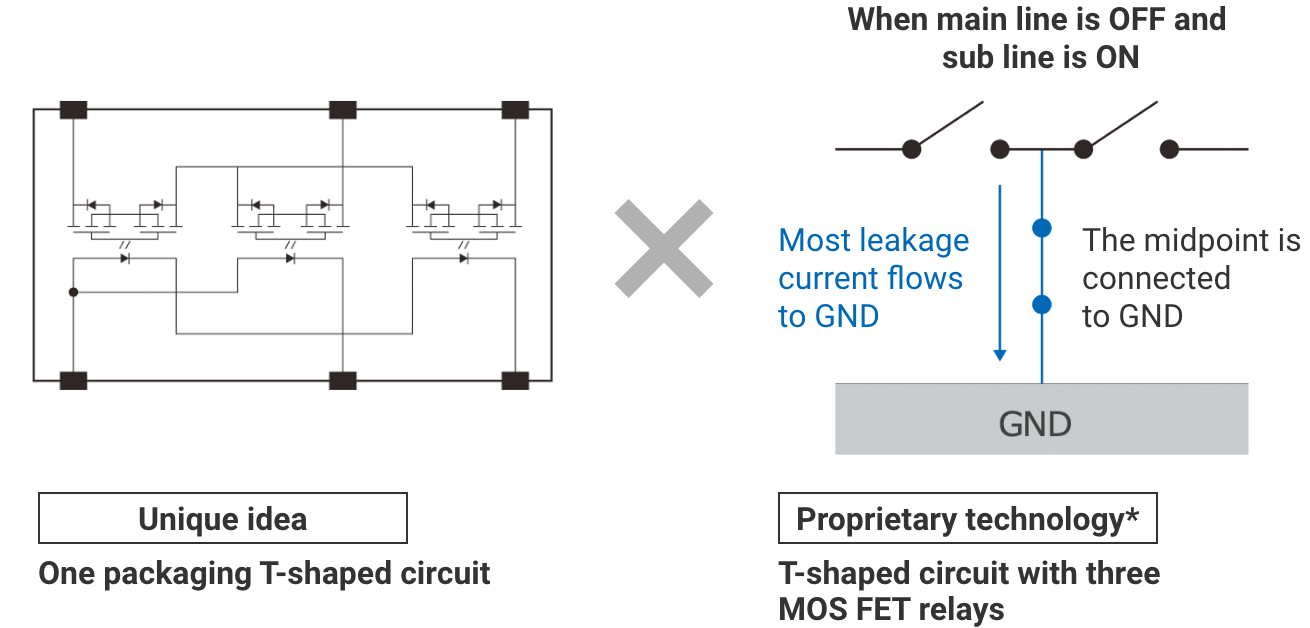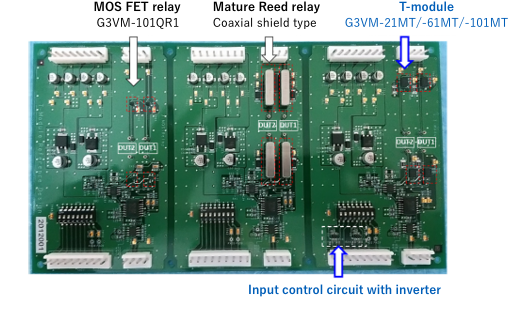- About
MOS FET Relay Module - G3VM-□M□
SPDT Contact Type - SPDT Contact Type
Product Lineup - G3VM-□MT
Ultra-Low Leakage Current Type - Ultra-Low Leakage Current Type
Product Lineup
MOS FET relay modules are products that combine a MOS FET relay with peripheral components and circuits in a single compact package to achieve performance that cannot be addressed with a single MOS FET relay.
While maintaining the advantages of semiconductor relays which are their small size and high reliability, the specifications come one step closer to those of contact relays. Ideal for replacing reed relays, mechanical relays, and other contact relays. Through modularization, we will further expand the possibilities of semiconductor relays.
What only MOS FET relay modules can do
OMRON's MOS FET relay modules include the SPDT contact type that can simultaneously control NO and NC contacts and the ultra-small leakage current type that achieves a leakage current ≤ 1 pA with a T-shaped circuit structure. These two types of MOS FET relay modules are especially suitable for measurement equipment and semiconductor inspection equipment.
Problems with single MOS FET relay ① :
No SPDT contact configuration

As semiconductor devices continue to rapidly evolve, there has been an increase in the reliability and diversity of measurement items in device characteristics inspection. To achieve high reliability, MOS FET relays are often used to replace conventional mechanical relays and reed relays. Since only NO or NC single-throw types are available, however, there is a concern that the control circuit can become complicated when replacing the double-throw (C-contact) type. With the increasing integration of printed circuit boards to realize multi-channel and diverse measurement functions, it is very important to design a concise control circuit.
OMRON has therefore developed a MOS FET relay module that combines two MOS FET relays and a control circuit in a single compact package. The simple control circuit enables SPDT operation equivalent to that of mechanical relays, while offering the high reliability of a semiconductor relay.
Problems with single MOS FET relay ② :
Leakage current occurrence

In measuring instruments and semiconductor inspection equipment, measurement accuracy is one of the most important issues, requiring stability and high resolution during repeated inspections. To achieve stability in repeated inspections, it is desirable to use MOS FET relays, which do not require physical contacts and exhibit stable on-resistance characteristics even after repeated switching. On the other hand, however, the resolution is inferior to that of mechanical relays due to leakage current caused by semiconductor relays. Since leakage current is a natural consequence of semiconductors, the common belief is that there is a trade-off between repeatability and resolution, but to achieve high accuracy, it is important to achieve both at a high level.
OMRON has therefore developed a MOS FET relay module in which three MOS FET relays are arranged in a T-shaped circuit and packed in a single, compact package. The relay contributes to high measurement accuracy by minimizing leakage current (≤ 1 pA) and achieving both repeatability and high resolution, despite being a semiconductor relay.

OMRON's proprietary technology* has enabled a semiconductor relay module that can easily construct SPDT contact configurations with a small footprint on the board.
* According to OMRON's research in July 2021
G3VM-66M (general-purpose type)
60V 0.4A output rating for a wide range of applications
G3VM-26M10 (low COFF type)
Suitable for high frequency (≤ 300 MHz) switching
G3VM-26M11 (low RON type)
Suitable for high current (≤ 1 A) switching


To configure SPDT contacts using semiconductor relays, complex circuits and multiple components are required.

Single-package design reduces man-hours for circuit design and component selection.
The complex set of circuits required for SPDT contact configuration is modularized (in single package) to simplify and streamline board design.


To configure SPDT contacts using semiconductor relays, a large board space is required.

The unique package technology* allows for a space-saving structure and a significant reduction in mounting space.
* According to OMRON's research in July 2021
Space can be reduced by approximately 78% compared to the case where the SPDT circuit is configured on a board. High-density mounting contributes to multi-functional and multi-channel devices.


Existing SPDT contact relays have a contact life and require periodic maintenance.

Adopting semiconductor relays with no physical contacts ensures long service life, contributing to reducing the frequency of periodic maintenance.
With no contact structure, an advantage of semiconductors, there is no arc discharge. Can be used without worrying about mechanical wear failure.
G3VM-□M□ (SPDT type) is available in three types: low COFF type, low RON type, and general-purpose type.
| G3VM-26M10 (low COFF type) |
G3VM-26M11 (low RON type) |
G3VM-66M (general-purpose type) |
|
|---|---|---|---|
| Number of terminals | 6 | 6 | 6 |
| Contact form | SPDT | SPDT | SPDT |
| Load voltage (max.) (V) |
20 | 20 | 60 |
| Continuous load current (max.) (mA) |
200 | 1,000 | 400 |
| Maximum resistance with output ON (typical) (Ω) |
4.4 | 0.21 | 1 |
| Current leakage when relay is open (max.) (nA) | 2 | 2 | 2 |
| Capacitance between terminals (typical) (pF) | 1 | 40 | 20 |
| Turn-ON time (max.) (ms) |
0.3 | 2.5 | 1 |
| Turn-OFF time (max.) (ms) |
0.3 | 1.5 | 1 |
| Rated input voltage (V) | 5 | 5 | 5 |
| Dielectric strength between I/O (Vrms) |
500 | 500 | 500 |
The G3VM-26M10 has good high-frequency characteristics up to the 300 MHz band due to its low pin-to-pin capacitance characteristics.


*1. Ambient temperature: +23C°
*2. High-frequency characteristics vary depending on the mounting board. Check the durability and other characteristics on the actual device before use.

For other G3VM-□M□ series documents,
please refer to the following.

The "T-shaped circuit structure" combining three MOS FET relays in a single package achieves minimal leakage current, contributing to improved measurement accuracy in semiconductor inspection equipment.

* According to OMRON's research in December 2019
When such a T-shaped circuit is configured on a board, the design becomes complicated, requiring more mounting space. An ultra-small leakage current type with a T-shaped circuit structure in a single package contributes to high-density mounting equivalent to the size of three rice grains.
G3VM-21MT (high isolation type)
Suitable for high frequency (≤ 1.5 GHz) switching
G3VM-61MT (high current type)
Suitable for 60V 0.8A (max.) switching
G3VM-101MT (high voltage type)
Suitable for 100V 0.55A (max.) switching


In semiconductor relays, leakage currents due to the structure are unavoidable. In addition to causing circuit malfunctions and performance degradation, they have also contributed to the deterioration of microcurrent measurement accuracy.

T-shaped circuit structure realizes leakage current ≤ 1 pA, suppressing circuit malfunction and supporting measurement of minute currents.
Leakage current ≤ 0.1 pA as actual value. With the same capability as a reed relay, the effect on the measurement accuracy of measuring instruments is minimized.


Contact relays are large in size and require a large board space.

Ultra-compact external size saves space.

Ultra-compact size is achieved while incorporating complex circuitry, achieving high-density mounting and contributing to multi-functional and multi-channel devices.


Contact relays such as reed relays and mechanical relays have a contact life and require periodic maintenance.

Adopting semiconductor relays with no physical contacts ensures long service life, contributing to reducing the frequency of periodic maintenance.
With no contact structure, an advantage of semiconductors, there is no arc discharge. Can be used without worrying about mechanical wear failure.
G3VM-□MT (ultra-low leakage current type) is available in three types: high isolation type, high current type, and high voltage type.
| G3VM-21MT (high isolation type) |
G3VM-61MT (high current type) |
G3VM-101MT (high voltage type) |
|
|---|---|---|---|
| Number of terminals | 6 | 6 | 6 |
| Contact form | 1a* | 1a* | 1a* |
| Load voltage (max.) (V) |
20 | 60 | 100 |
| Continuous load current (max.) (mA) |
200 | Io Main : 800 Io Sub : 400 |
550 |
| Maximum resistance with output ON (typical) (Ω) |
8 | 0.4 | 0.8 |
| Current leakage when relay is open (max.) (pA) | 1 | 1 | 1 |
| Capacitance between terminals (typical) (pF) |
0.6 | 38 | 23 |
| Turn-ON time (max.) (ms) |
0.3 | 2.5 | 2.5 |
| Turn-OFF time (max.) (ms) |
0.3 | 0.5 | 0.5 |
| Dielectric strength between I/O (Vrms) |
500 | 500 | 500 |
*For details, please refer to the product data sheet "●Operation Mode" on the product detail page.
The high isolation type G3VM-21MT is a product with particularly excellent high-frequency characteristics and has good characteristics up to the 1.5 GHz band.


*1. Ambient temperature: +25C°
*2. High-frequency characteristics vary depending on the mounting board. Check the durability and other characteristics on the actual device before use.
Reference Design Report
In the testing and measurement industry, the measurement accuracy and reliability of equipment are extremely important, and naturally, the relays that are often used to switch various measurement circuits within equipment must also have high performance and reliability. Therefore, OMRON offers a G3VM-□MT reference design.
G3VM-□MT is a compact semiconductor relay module that employs a "T-shaped circuit structure" in semiconductor relays. While maintaining the long life and stable on-resistance characteristics of semiconductor relays, this product has achieved an ultra-low leakage current comparable to that of reed relays, and can be used in applications where MOS FET relays have been difficult to replace. This reference design contains a reference example of circuit design using the G3VM-□MT as an example of circuit switching in the DC test section, as well as the results of a comparison and verification of measurement accuracy effect with existing reed relays and MOS FET relays.
※Measurement methods and detailed result reports for the reference design board are also available.
For details, contact OMRON's sales department.


For other G3VM-□MT series documents,
please refer to the following.















